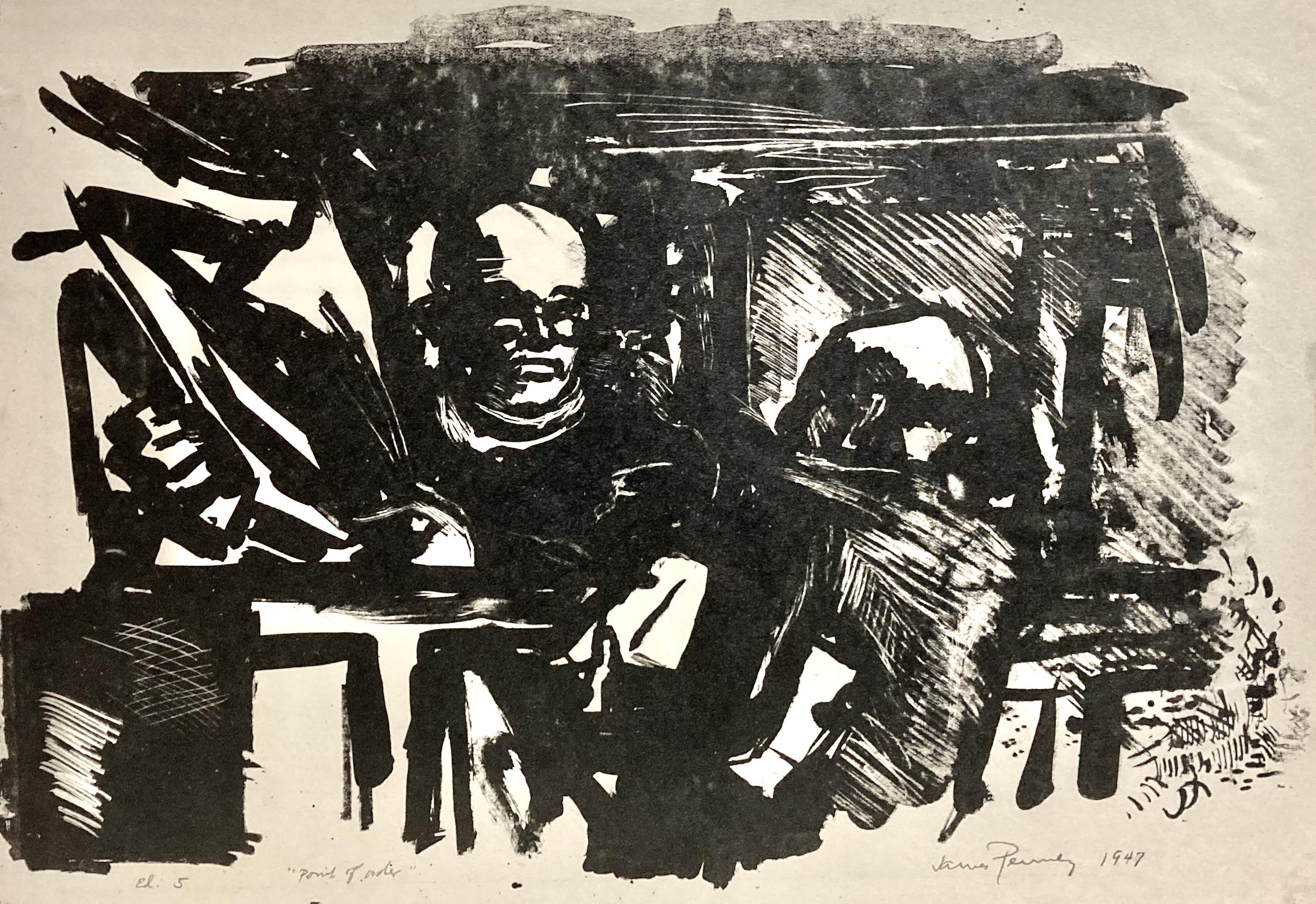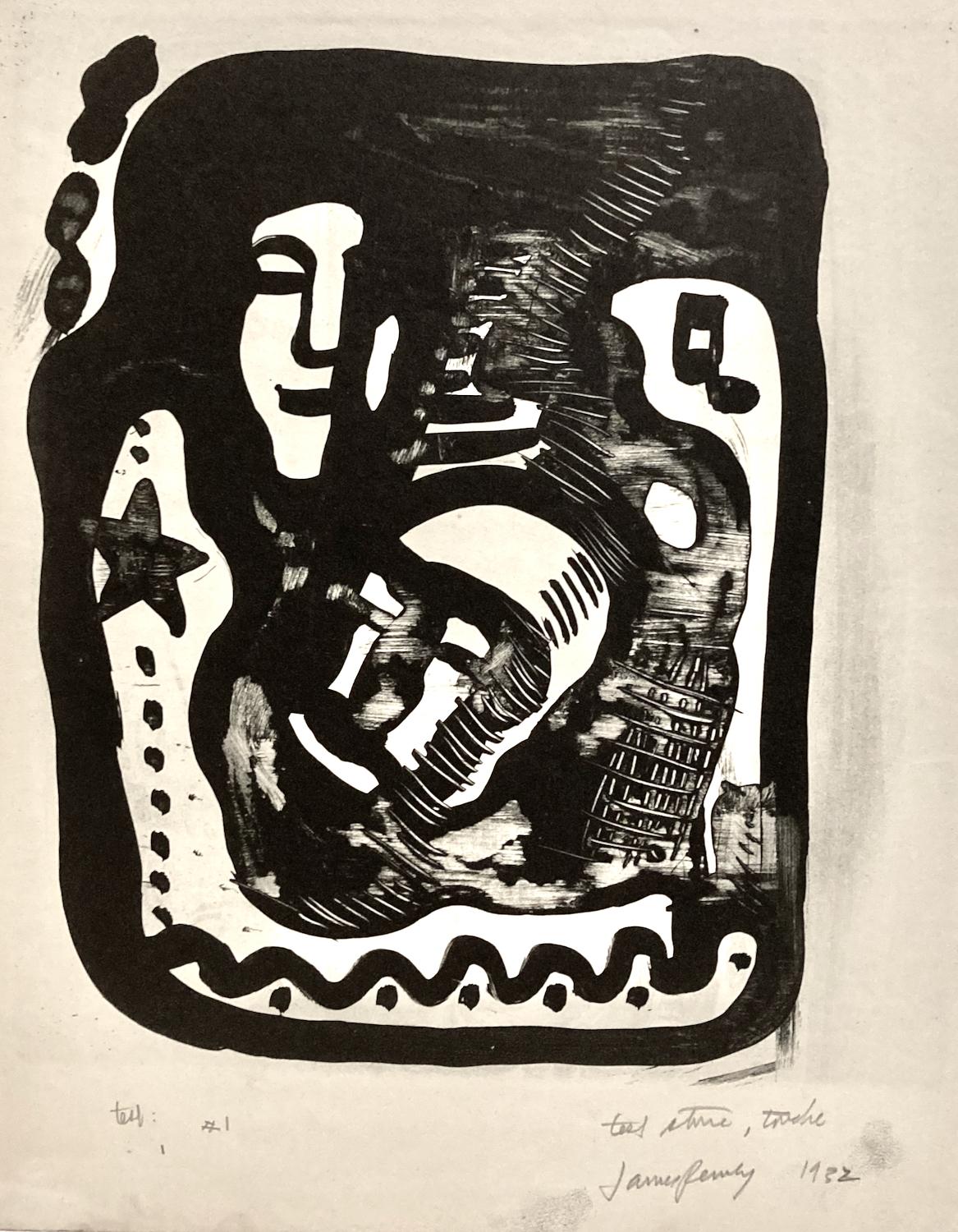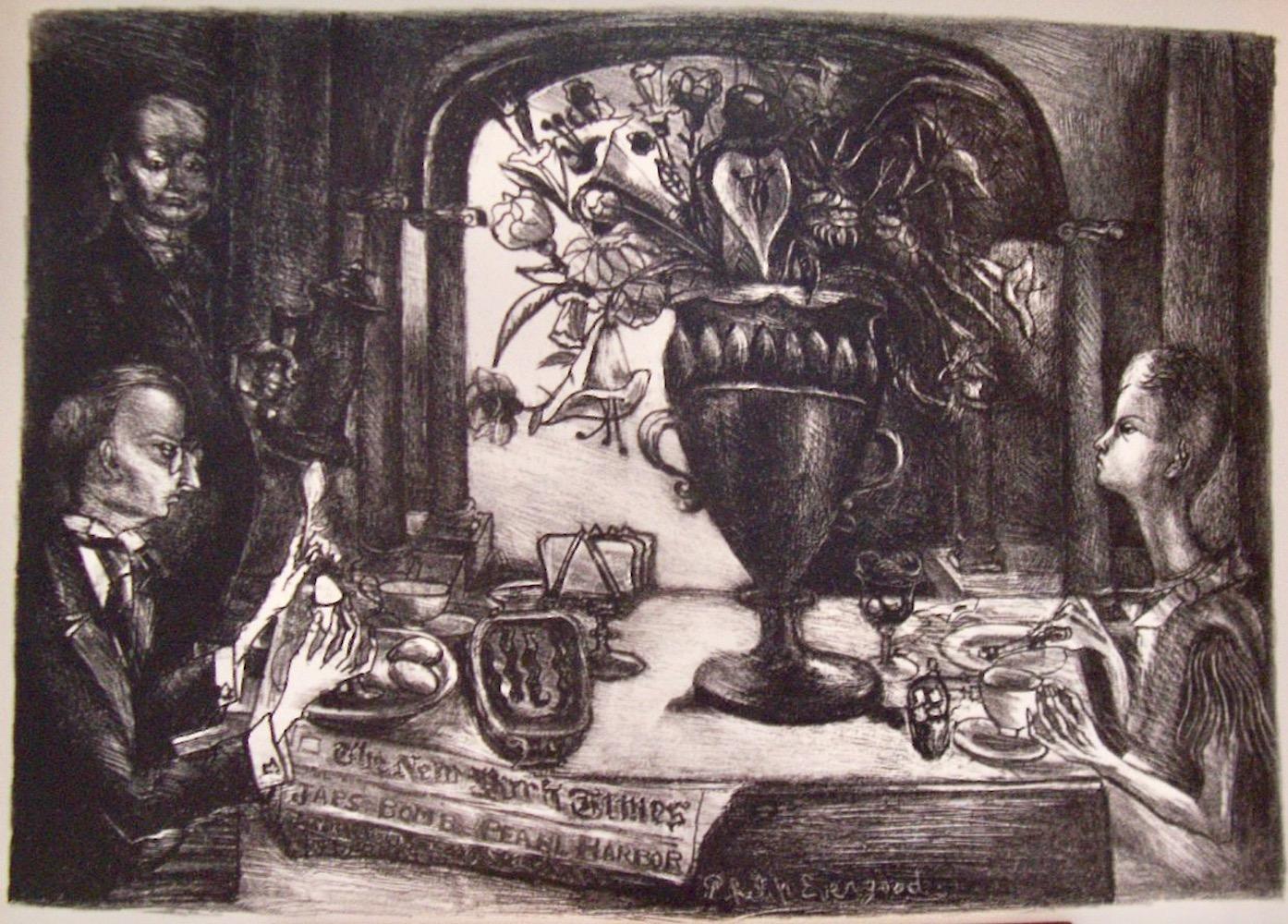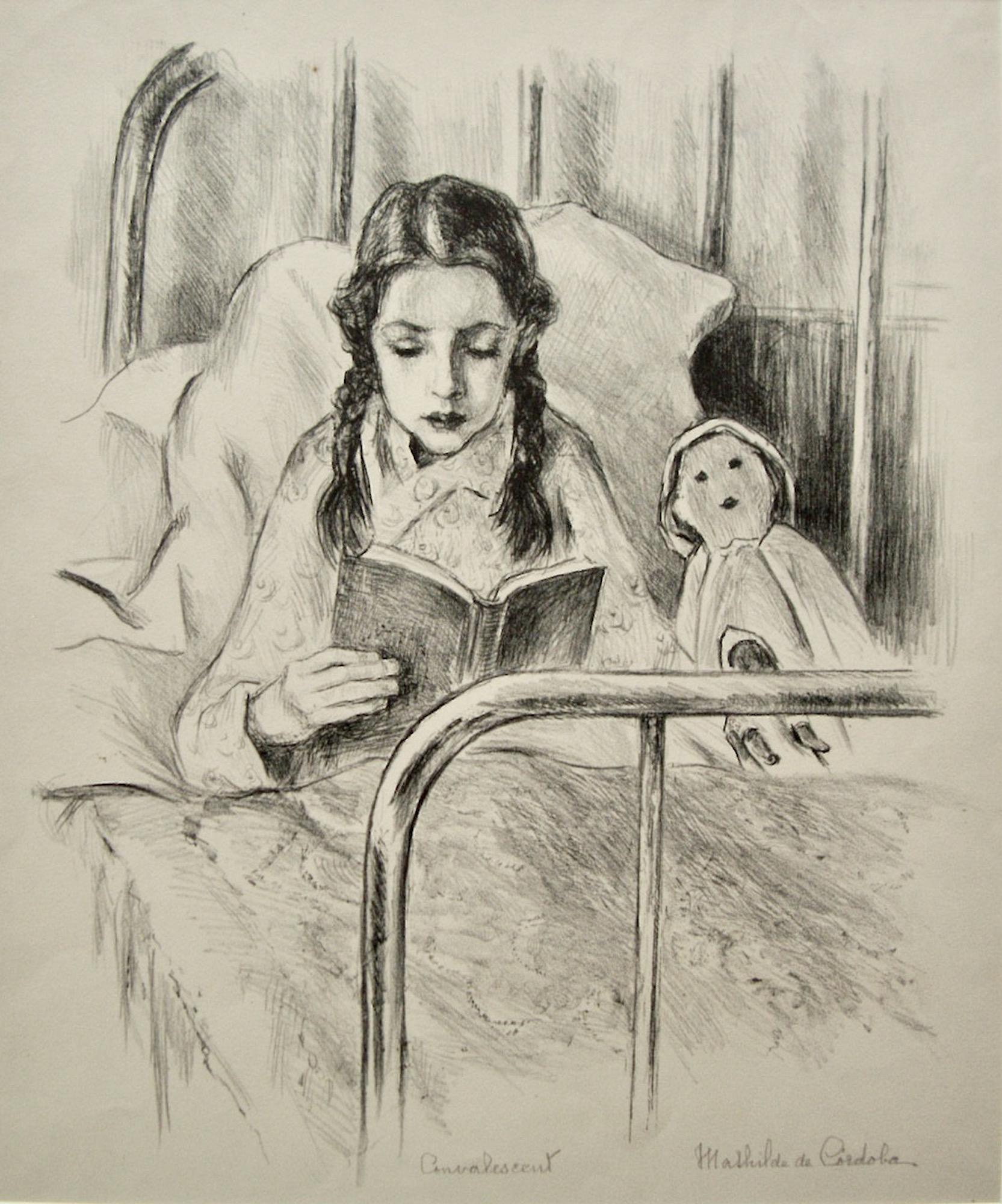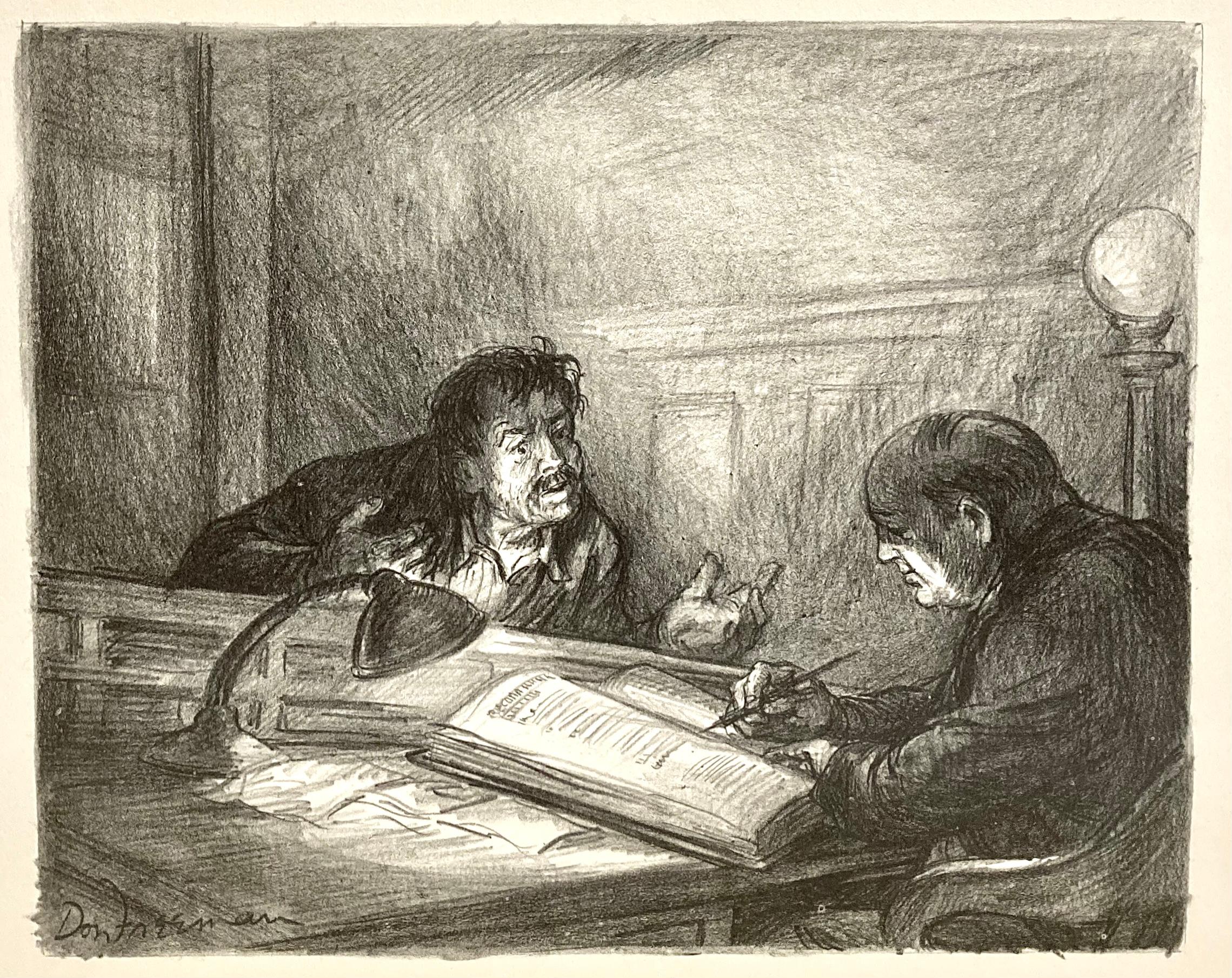Items Similar to "Business-Men's Class, Y.M.C.A." George Bellows, Ashcan School Print
Want more images or videos?
Request additional images or videos from the seller
1 of 9
George Wesley Bellows"Business-Men's Class, Y.M.C.A." George Bellows, Ashcan School Print1916
1916
About the Item
George Bellows
Business-Men's Class, Y.M.C.A, 1916
Signed, numbered "No. 41" and titled lower margin
Lithograph on wove paper
11 1/2 x 17 1/8 inches
Edition of 64
Provenance:
Hirschl & Adler Galleries, New York
Private Collection, Ohio
Literature:
Mason, 20.
After his arrival from Columbus, Ohio in 1904, Bellows lived at the West Side YMCA. It was there that he met Eugene Speicher, another aspiring young artist who was to become his lifelong friend. Always interested in the anatomy of the human body, Bellows often satirized the various types who, while leading a sedentary life, feel compelled to devote a portion of their daily routine to physical self-improvement.
Throughout his brief but illustrious career, George Wesley Bellows created striking scenes that documented ordinary American life in all its beauty and banality. Considered an American Realist, the artist eschewed embellishment, finding inspiration in the gritty boroughs of New York City, the rocky coastline of Maine, and, later, in his friends and family. Bellows garnered early recognition for his arresting portrayals of illegal prizefighting, dramatic works executed in dark tonal palettes that underscore the brutality of the violent sport.
Bellows’ elderly Methodist parents hoped their son might pursue the ministry, a calling the extroverted athlete never received. The Columbus native competed on the baseball team at Ohio State University and also served as an illustrator for the college yearbook. In the fall of 1904—just months shy of his expected graduation—Bellows defied his father’s wishes and boarded a train to New York City in hopes of becoming a magazine illustrator like his idols Howard Chandler Christy and Charles Dana Gibson. Before leaving, he reportedly turned down an offer to play professional baseball with the Cincinnati Reds.
Upon his arrival, Bellows enrolled in courses at the New York Art School, also called the “Chase School” after its renowned founder and the pioneer of American Impressionism, William Merritt Chase. He received instruction from Chase, as well as Robert Henri, a fellow Midwesterner who first encouraged Bellows to take to the streets of Manhattan in search of subject matter. Henri was the leader of an informal association of artists known as “The Eight.” These men spurned the confines of the European academic tradition and chose instead to record working-class street life, in all its color and complexity, with unvarnished realism. The group—which, along with Bellows and Henri, included William Glackens, Ernest Lawson, George Luks, Maurice Prendergast, Everett Shinn, and John Sloan—was later identified as “Ashcan School,” a designation derived from Bellows’s grim drawing Disappointments of the Ash Can (1915), in which three men examine the worm-ridden contents of a filthy waste receptacle.
Bellows’s vigorously executed oil paintings met with early critical and commercial success. He was elected an associate of the National Academy of Design in 1909, and full membership accrued in 1913—notable achievements for such a young artist. Along with his teaching duties at the Art Students League, Bellows produced over 170 lithographic images and was a prolific illustrator. He contributed to many of the popular periodicals of the day, including Vanity Fair, Harper’s Weekly, and Metropolitan Magazine, as well as the socialist publication The Masses. Indeed, many of Bellows’s drawing and prints reveal an acute interest in social and political issues, such as a series that gruesomely detailed German atrocities during World War I. Intrigued by the modernist art theories emanating from Europe, Bellows was an organizer and exhibitor at the landmark Armory Show of 1913. When he succumbed to peritonitis—triggered by a ruptured appendix—in January of 1925, the forty-two-year-old was considered one of the most popular painters in America.
In 1908, Bellows accepted a six-week summer teaching position at the University of Virginia in Charlottesville, during which time he painted Footpath Virginia. Markedly different in composition and style from his New York scenes, the loosely-painted Footpath depicts two women taking a leisurely stroll on a summer day. One of the vignette’s subjects has been identified as Miss Marie Ellis Bowles of Staunton, Virginia, a student to whom Bellows gave the painting. Footpath is one of three works that Bellows completed during his Southern stay.
- Creator:George Wesley Bellows (1882-1925, American)
- Creation Year:1916
- Dimensions:Height: 21.5 in (54.61 cm)Width: 25.5 in (64.77 cm)
- Medium:
- Movement & Style:
- Period:
- Condition:
- Gallery Location:New York, NY
- Reference Number:1stDibs: LU1841211362342
About the Seller
5.0
Platinum Seller
These expertly vetted sellers are 1stDibs' most experienced sellers and are rated highest by our customers.
Established in 2021
1stDibs seller since 2022
59 sales on 1stDibs
Typical response time: 1 hour
- ShippingRetrieving quote...Ships From: New York, NY
- Return PolicyA return for this item may be initiated within 3 days of delivery.
More From This SellerView All
- "Thanksgiving" Doris Lee, Family Genre Scene Interior, Americana, WPA, WoodstockBy Doris LeeLocated in New York, NYDoris Lee Thanksgiving, 1942 Signed lower right, titled lower left Lithograph on paper Image 8 3/4 x 11 3/4 inches Sheet 12 x 17 inches From the edition of 250 An American Scene pai...Category
1940s American Realist Interior Prints
MaterialsPaper, Lithograph
- "The Capture, " Jacob Lawrence, Harlem Renaissance, Black Art, Haitian SeriesBy Jacob LawrenceLocated in New York, NYJacob Lawrence (1917 - 2000) The Capture of Marmelade (from The Life of Toussaint L'Ouverture series), 1987 Color screenprint on Bainbridge Two Ply Rag paper Sheet 32 1/8 x 22 1/16 inches Sight 29 3/4 x 19 1/4 inches A/P 1/30, aside from the edition of 120 Signed, titled, dated, inscribed "A/P" and numbered 1/30 in pencil, lower margin. Literature: Nesbett L87-2. A social realist, Lawrence documented the African American experience in several series devoted to Toussaint L’Ouverture, Frederick Douglass, Harriet Tubman, life in Harlem, and the civil rights movement of the 1960s. He was one of the first nationally recognized African American artists. “If at times my productions do not express the conventionally beautiful, there is always an effort to express the universal beauty of man’s continuous struggle to lift his social position and to add dimension to his spiritual being.” — Jacob Lawrence quoted in Ellen Harkins Wheat, Jacob Lawrence: The Frederick Douglass and Harriet Tubman Series of 1938 – 40. The most widely acclaimed African American artist of this century, and one of only several whose works are included in standard survey books on American art, Jacob Lawrence has enjoyed a successful career for more than fifty years. Lawrence’s paintings portray the lives and struggles of African Americans, and have found wide audiences due to their abstract, colorful style and universality of subject matter. By the time he was thirty years old, Lawrence had been labeled as the “foremost Negro artist,” and since that time his career has been a series of extraordinary accomplishments. Moreover, Lawrence is one of the few painters of his generation who grew up in a black community, was taught primarily by black artists, and was influenced by black people. Lawrence was born on September 7, 1917,* in Atlantic City, New Jersey. He was the eldest child of Jacob and Rosa Lee Lawrence. The senior Lawrence worked as a railroad cook and in 1919 moved his family to Easton, Pennsylvania, where he sought work as a coal miner. Lawrence’s parents separated when he was seven, and in 1924 his mother moved her children first to Philadelphia and then to Harlem when Jacob was twelve years old. He enrolled in Public School 89 located at 135th Street and Lenox Avenue, and at the Utopia Children’s Center, a settlement house that provided an after school program in arts and crafts for Harlem children. The center was operated at that time by painter Charles Alston who immediately recognized young Lawrence’s talents. Shortly after he began attending classes at Utopia Children’s Center, Lawrence developed an interest in drawing simple geometric patterns and making diorama type paintings from corrugated cardboard boxes. Following his graduation from P.S. 89, Lawrence enrolled in Commerce High School on West 65th Street and painted intermittently on his own. As the Depression became more acute, Lawrence’s mother lost her job and the family had to go on welfare. Lawrence dropped out of high school before his junior year to find odd jobs to help support his family. He enrolled in the Civilian Conservation Corps, a New Deal jobs program, and was sent to upstate New York. There he planted trees, drained swamps, and built dams. When Lawrence returned to Harlem he became associated with the Harlem Community Art Center directed by sculptor Augusta Savage, and began painting his earliest Harlem scenes. Lawrence enjoyed playing pool at the Harlem Y.M.C.A., where he met “Professor” Seifert, a black, self styled lecturer and historian who had collected a large library of African and African American literature. Seifert encouraged Lawrence to visit the Schomburg Library in Harlem to read everything he could about African and African American culture. He also invited Lawrence to use his personal library, and to visit the Museum of Modern Art’s exhibition of African art in 1935. As the Depression continued, circumstances remained financially difficult for Lawrence and his family. Through the persistence of Augusta Savage, Lawrence was assigned to an easel project with the W.P.A., and still under the influence of Seifert, Lawrence became interested in the life of Toussaint L’Ouverture, the black revolutionary and founder of the Republic of Haiti. Lawrence felt that a single painting would not depict L’Ouverture’s numerous achievements, and decided to produce a series of paintings on the general’s life. Lawrence is known primarily for his series of panels on the lives of important African Americans in history and scenes of African American life. His series of paintings include: The Life of Toussaint L’Ouverture, 1937, (forty one panels), The Life of Frederick Douglass, 1938, (forty panels), The Life of Harriet Tubman, 1939, (thirty one panels), The Migration of the Negro,1940 – 41, (sixty panels), The Life of John Brown, 1941, (twenty two panels), Harlem, 1942, (thirty panels), War, 1946 47, (fourteen panels), The South, 1947, (ten panels), Hospital, 1949 – 50, (eleven panels), Struggle: History of the American People, 1953 – 55, (thirty panels completed, sixty projected). Lawrence’s best known series is The Migration of the Negro, executed in 1940 and 1941. The panels portray the migration of over a million African Americans from the South to industrial cities in the North between 1910 and 1940. These panels, as well as others by Lawrence, are linked together by descriptive phrases, color, and design. In November 1941 Lawrence’s Migration series was exhibited at the prestigious Downtown Gallery in New York. This show received wide acclaim, and at the age of twenty four Lawrence became the first African American artist to be represented by a downtown “mainstream” gallery. During the same month Fortune magazine published a lengthy article about Lawrence, and illustrated twenty six of the series’ sixty panels. In 1943 the Downtown Gallery exhibited Lawrence’s Harlem series, which was lauded by some critics as being even more successful than the Migration panels. In 1937 Lawrence obtained a scholarship to the American Artists School in New York. At about the same time, he was also the recipient of a Rosenwald Grant for three consecutive years. In 1943 Lawrence joined the U.S. Coast Guard and was assigned to troop ships that sailed to Italy and India. After his discharge in 1945, Lawrence returned to painting the history of African American people. In the summer of 1947 Lawrence taught at the innovative Black Mountain College in North Carolina at the invitation of painter Josef Albers. During the late 1940s Lawrence was the most celebrated African American painter in America. Young, gifted, and personable, Lawrence presented the image of the black artist who had truly “arrived”. Lawrence was, however, somewhat overwhelmed by his own success, and deeply concerned that some of his equally talented black artist friends had not achieved a similar success. As a consequence, Lawrence became deeply depressed, and in July 1949 voluntarily entered Hillside Hospital in Queens, New York, to receive treatment. He completed the Hospital series while at Hillside. Following his discharge from the hospital in 1950, Lawrence resumed painting with renewed enthusiasm. In 1960 he was honored with a retrospective exhibition and monograph prepared by The American Federation of Arts. He also traveled to Africa twice during the 1960s and lived primarily in Nigeria. Lawrence taught for a number of years at the Art Students League in New York, and over the years has also served on the faculties of Brandeis University, the New School for Social Research, California State College at Hayward, the Pratt Institute, and the University of Washington, Seattle, where he is currently Professor Emeritus of Art. In 1974 the Whitney Museum of American Art in New York held a major retrospective of Lawrence’s work that toured nationally, and in December 1983 Lawrence was elected to the American Academy of Arts and Letters. The most recent retrospective of Lawrence’s paintings was organized by the Metropolitan Museum of Art in 2020, and was accompanied by a major catalogue. Lawrence met his wife Gwendolyn Knight...Category
1970s American Modern Figurative Prints
MaterialsScreen, Paper
- "La Danse Barbare (from Les Saltimbanques), " Pablo Picasso, Figurative PrintBy Pablo PicassoLocated in New York, NYPablo Picasso (1881 - 1973) La Danse Barbare (from La Suite des Saltimbanques), 1905, printed 1913 Etching on Van Gelder Zonen wove paper Sheet 13 x 20 inches From the edition of 250...Category
Early 1900s Modern Figurative Prints
MaterialsPaper, Etching
- "Flower Girl, " John George Brown, Genre Painting, Street FigureBy John George BrownLocated in New York, NYJohn George Brown (1831 - 1913) Flower Girl, circa 1900 Watercolor on paper 6 3/4 x 4 3/4 inches Signed lower left Period Hand Carved Foster Brothers Fram...Category
Early 1900s Ashcan School Figurative Paintings
MaterialsPaper, Watercolor
- "Reclining Nude" Everett Shinn, Figurative Woman Watercolor, Ashcan SchoolBy Everett ShinnLocated in New York, NYEverett Shinn Reclining Nude, 1940 Signed and dated lower left Watercolor on paper 4 1/2 x 9 inches Provenance: Christie's New York, Interiors, August 28, 2012, Lot 181 Private Collection Everett Shinn, a future member of the Eight and remarkable, rather theatrical personality was born at Woodstown, New Jersey in 1873. Even more recent sources give 1876 as the year of Everett Shinn's birth but the artist usually lied about his age to appear younger than he actually was. Edith DeShazo claimed that information from family members established the date of November 6, 1876 as Shinn's birthday. But if this is true, he would have enrolled at the Spring Garden Institute in Philadelphia to study industrial art at the age of twelve. Born to a Quaker named Isaiah Conklin Shinn and Josephine Ransley Shinn, Everett was their third child. He enjoyed a happy childhood as an undisciplined boy fond of sweets, acrobatics, and the circus. Shinn opted for the Pennsylvania Academy of the Fine Arts for instruction in the fall of 1893, and began as a staff artist for the Philadelphia Press. At that time William Glackens was working there as well, while John Sloan was at the Inquirer. A year later, Glackens was at the Press, and also, in 1894, George Luks joined the staff there. As DeShazo explained, "the Press art department became a meeting place for men both on the staff and off with similar artistic and literary interests." Members of the same group also met at Robert Henri's studio. By 1897, Shinn was in New York, working for the New York World where Luks had been for about a year. The rest of the "Philadelphia Four" would follow them before long. Shinn spent much of 1898 hounding the offices of Harper's until finally, the editor and publisher, Colonel George Harvey saw his portfolio, then commissioned a view of the Old Metropolitan Opera House in a snowstorm. The pastel appeared about a year later in the February 17th issue of Harper's Weekly, in 1900. Meanwhile, Shinn kept busy with decorative work (murals, screens, and door panels) at private residences and even in Trenton, New Jersey's City Hall. In 1899, the Boussod-Valadon Galleries gave Shinn his first one-man show. He continued to carry out commissions for illustrations. Shinn began exhibiting at the Pennsylvania Academy (1899-1908) and at the Art Institute of Chicago (1903-43). A trip to Europe is documented in 1900 by an exhibition at Goupil's in Paris and by various drawings of Paris...Category
1940s Ashcan School Figurative Drawings and Watercolors
MaterialsWatercolor, Paper
- "Street Fair” William Glackens, Ashcan School, Street Scene, Carnival, BoxingBy William GlackensLocated in New York, NYWilliam Glackens Street Fair, circa 1905 Pencil, ink and gouache on paper 10 x 14 inches Provenance: The artist Kraushaar Galleries, New York Estate ...Category
Early 1900s Ashcan School Landscape Drawings and Watercolors
MaterialsGouache, Pencil, Paper, Ink
You May Also Like
- James Penney, Point of OrderBy James PenneyLocated in New York, NYJames Penney was widely known for his New Yorker covers as well as his paintings and prints. Penney was from Saint Joseph, Missouri. He trained in NYC at the Art Students League. The New-York Historical Society and the Library of Congress both have collections of his work. Signed, titled, and dated. Especially like the test marks at the lower right and the way the lawyer is leaning/relaxing on the judge...Category
Mid-20th Century Ashcan School Interior Prints
MaterialsLithograph
- Eli Jacobi, Raritan Bridge (New Jersey)Located in New York, NYMostly known linocuts that combine social subjects with a modernist figure-ground style, Jacobi proves that 'artists have hands.' By that my old boss Sylvan Cole meant that even if they have a preferred medium, like Jacobi with linocut, they could do just about anything. And here the artist has made a New Jersey subject shine. The Raritan Bridge of course goes over the Raritan River that flows from the inland mountains (well, hills) of New Jersey to the Raritan Bay and then into the Atlantic Ocean. It was stolen from the Lenape by the Dutch and fought over by the English. It's role in American Industrial History is the stuff of legends. With the addition of a canal it transported anthracite coal from Pennsylvania helping to make the this part of New Jersey into a financial powerhouse. Sadly industry also polluted the entire region but now there is on-going restoration. Of course the bridge is also known to riders of the New Jersey Coast Line and drivers on the Garden State Parkway -- both take travelers 'down the shore,' This twist of heavy industry...Category
1940s Ashcan School Landscape Prints
MaterialsLithograph
- Philip Evergood, (The New York Times)By Philip EvergoodLocated in New York, NYThe ever-quirky Philip Evergood has composed a print that is at once a World War II image (The New York Times on the table has the headline 'Japs Bomb P...Category
Mid-20th Century Ashcan School Figurative Prints
MaterialsLithograph
- ConvalescentLocated in New York, NYMathilde de Cordoba was born in New York City and spent her career there. She is known for her studies of women and children. Convalescent is sign...Category
1930s Ashcan School Interior Prints
MaterialsLithograph
- James Penney, CorridorBy James PenneyLocated in New York, NYJames Penney was widely known for his New Yorker covers as well as his paintings and prints. Penney was from Saint Joseph, Missouri. He trained in NY...Category
1930s Ashcan School Interior Prints
MaterialsLithograph
- Don Freeman, (At the Booking Desk)By Don FreemanLocated in New York, NYDon Freeman is best known for his paintings and works on paper of New York City's theatre industry: the signage, the stages and sets, the actors, the costumers and ushers, anything a...Category
Mid-20th Century Ashcan School Interior Prints
MaterialsLithograph
